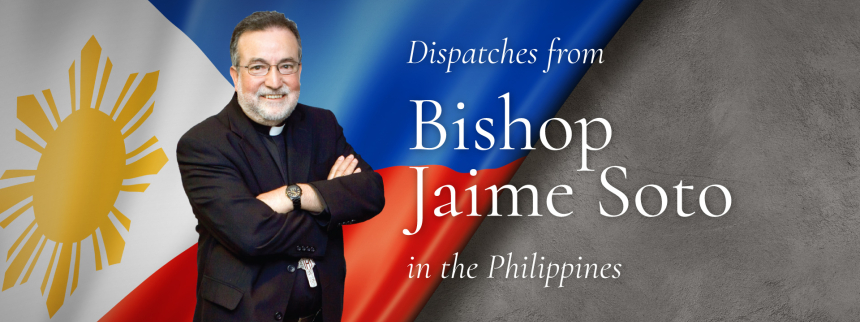
On Friday we arrived by plane to Tacloban City, a place made well-known by the devastating Typhoon Haiyan in 2013, also known as Tropical Storm Yolanda.
The storm-swept fate of the Leyte region comes because the island faces into the Pacific Ocean. Out in this vast deep body of water brews and stews many of the tempests large and small that taunt the Southeast Asia and the Pacific islands with increasing catastrophic potency in recent years. As a testament to this, all our days in these islands perched on the Pacific, rains — from drizzles to torrents — have accompanied us from dawn to dusk.
To this tropical place came the Lord Jesus in 1521. Brought by the same unpredictable ocean winds came the galleons of Magellan to the island of Limasawa. Here the first Mass in the Philippines was offered on Easter Sunday, March 31, 1521. Jesus offered himself as the Bread of Life and the Cup of Salvation to the people of the Philippines. I offered Mass at the Shrine erected at one of the locations believed to be where the first Mass took place.
Afterwards, we were taken to the parish Church, dedicated in honor of St. Isidore, the Farmer. This is the other location where it is alleged that the first Mass was offered. I am not familiar with all the mountain of historical research around this controversy, but the site of the parish church seems more probable to this pilgrim. It is closer to the shore and the location speaks of where the popular memory would have continued to honor when the Eucharistic Christ was first broken and shared among the faithful.
The swirling controversy about the location may see like a pointless fuss unless we understand the fundamental point: The person of Jesus, Son of God and Son of Mary, came to this place. Early in the gospel of Mark, Jesus preached and worked powerful signs in the small town of Capernaum. His first disciples were content to remain in this thriving village on the shores of the Galilean Sea. Could not the Divine Messiah have saved Israel and the whole world staying in one place? This was not the plan. On rising one morning after prayer Jesus told them, “Let us go on to the nearby villages that I may preach there also. For this purpose have I come.” (Mk. 1.38). The restless missionary spirit of Jesus sought to bring the mercy and wisdom of God by being present and active in a personal way. The same Jesus, who set out with his disciples from Capernaum, came to the shores of Limasawa in 1521 because “for this purpose have I come.”
To get to Limasawa the pilgrims rode two small motor launches from the southern tip of the Leyte island to the small island where Magellan and his crew landed. Going over was uneventful. Returning, the waters were choppy and a strong cool breeze teased our boats with saltwater spray. Needless to say, I did not need to encourage prayer onboard. Rosaries, the divine mercy chaplet, the reading of scriptures, and other forms of piety were all around. We turned from Limasawa stronger in our faith.
Bishop Jaime Soto is currently on pilgrimage in the Philippines with a group of clergy and laity from the Diocese of Sacramento. Stay tuned to our News page for more of Bishop Soto's reflections from this pilgrimage.
Read more: First Dispatch - Second Dispatch - Third Dispatch - Fourth Dispatch - Fifth Dispatch

